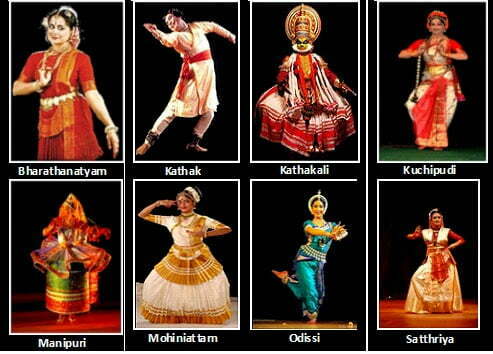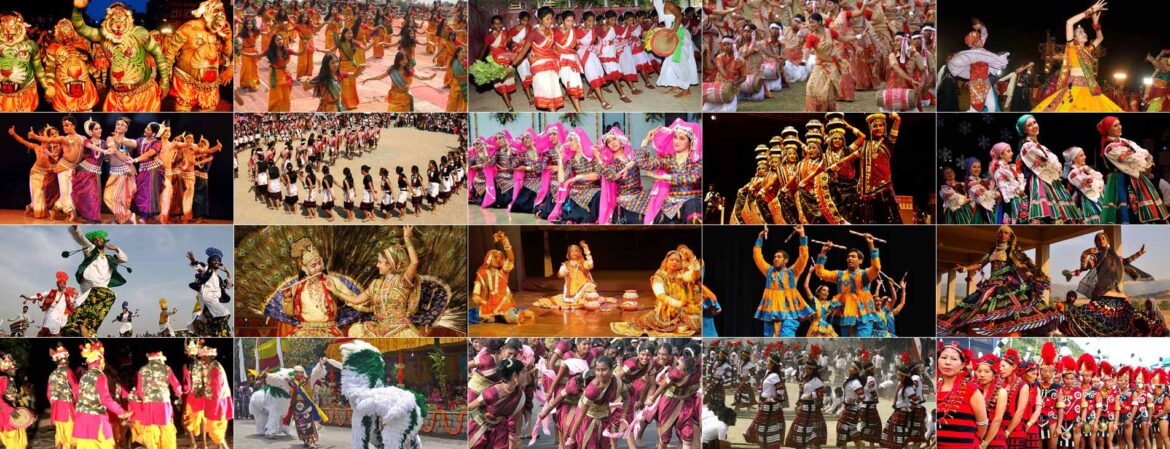Table of Contents
Indian dance forms have a rich history that is as diverse and vibrant as the country itself. With roots that date back thousands of years, these dances have evolved, adapted, and flourished, reflecting the changing socio-cultural landscape of India. From the classical dances that adhere strictly to ancient texts and traditions to contemporary forms that embrace modernity and innovation, the journey of Indian dance is a testament to the enduring power of art to evolve while preserving its essence.
Classical Indian Dance Forms
Classical dance forms in India are deeply embedded in the cultural and religious fabric of the country. These dances are not merely performances but are seen as a form of worship and a means to express devotion to the divine. They are characterized by their strict adherence to the Natya Shastra, an ancient Indian treatise on performing arts written by the sage Bharata Muni.
1. Bharatanatyam
Originating from Tamil Nadu, Bharatanatyam is one of the oldest classical dance forms in India. Traditionally performed by Devadasis (temple dancers), it is known for its intricate footwork, expressive hand gestures (mudras), and elaborate facial expressions. Bharatanatyam performances often depict stories from Hindu mythology, particularly the epics of Ramayana and Mahabharata.

2. Kathak
Kathak, which means “to tell a story,” originated in the northern regions of India. It is characterized by its graceful movements, intricate footwork, and rapid spins. Kathak dancers use a series of rhythmic patterns called ‘tihai’ and ‘chakradhar’ to mesmerize the audience. Over the centuries, Kathak has been influenced by Persian and Mughal cultures, which introduced more fluid movements and the incorporation of musical instruments like the tabla and harmonium.
3. Kathakali
Hailing from Kerala, Kathakali is a highly stylized form of dance-drama. It is known for its elaborate costumes, vibrant makeup, and intricate gestures. Kathakali performers undergo rigorous training to perfect their expressions and movements. The themes of Kathakali performances are typically derived from Hindu epics and Puranas, and the dancers use a combination of facial expressions (rasas) and hand gestures (mudras) to convey the story.
4. Odissi
Odissi, from Odisha, is a dance form that combines elements of sculpture-like poses, intricate footwork, and fluid movements. It is known for its grace and spirituality, often portraying the divine love of Radha and Krishna. The dance is performed in three parts: Mangalacharan (invocation), Pallavi (pure dance), and Abhinaya (expressive dance). Odissi dancers use their entire body to convey emotions, making it one of the most expressive classical dance forms.
5. Kuchipudi
Kuchipudi, from Andhra Pradesh, is unique in that it combines both dance and drama. It was traditionally performed as a dance-drama by male artists, but today, it is predominantly performed by female dancers. Kuchipudi is characterized by its fast rhythms, spirited movements, and the use of speech and dialogue. Performers often dance on the edges of a brass plate, showcasing their balance and dexterity.
6. Manipuri
Manipuri dance, from the northeastern state of Manipur, is known for its lyrical and graceful movements. It is deeply connected to the rituals and traditions of the region, particularly the worship of the Hindu gods Radha and Krishna. The dance is characterized by its fluid arm and hand movements, soft footwork, and a serene and meditative quality.
The Influence of Colonial Rule
The advent of British colonial rule in India had a profound impact on Indian dance forms. During this period, traditional art forms faced neglect and decline as Western cultural values and forms of entertainment gained prominence. Many classical dance traditions were suppressed, and the patronage they once enjoyed from kings and local chieftains dwindled.
However, the early 20th century saw a revival of interest in Indian classical dance, led by pioneers like Rukmini Devi Arundale (Bharatanatyam), Uday Shankar (modern Indian dance), and others who sought to preserve and promote India’s rich cultural heritage. These visionaries played a crucial role in reviving classical dance forms, establishing institutions for training, and bringing Indian dance to the global stage.
The Birth of Contemporary Indian Dance
As India moved towards independence and beyond, there was a growing desire to express contemporary realities and explore new artistic expressions. This led to the emergence of contemporary Indian dance, which blends classical forms with modern techniques and themes.
1. The Influence of Uday Shankar
Uday Shankar is often credited as the father of modern Indian dance. Inspired by both Western and Indian dance forms, he created a unique style that incorporated elements of classical dance, folk traditions, and contemporary movements. Shankar’s choreography often addressed social and political themes, and his innovative approach paved the way for future generations of contemporary dancers.
2. Modern Indian Dance Pioneers
Several choreographers and dancers have contributed to the growth of contemporary Indian dance. Among them, Chandralekha stands out for her bold and radical approach. She combined Bharatanatyam with elements of yoga and martial arts, exploring themes of gender, sexuality, and human rights. Her work challenged traditional norms and expanded the boundaries of Indian dance.
Astad Deboo is another prominent figure in the contemporary dance scene. He is known for his fusion of Kathak and contemporary dance, creating a distinctive style that is both innovative and deeply rooted in tradition. Deboo’s performances often incorporate visual arts, music, and theatre, resulting in a multidisciplinary approach to dance.
3. The Role of Dance Institutions
Institutions like the Danceworx Academy, Attakkalari Centre for Movement Arts, and Nrityagram have played a significant role in promoting contemporary dance in India. These institutions provide training in various dance styles, encourage experimentation, and foster a vibrant dance community. They also host festivals and workshops that bring together dancers from different backgrounds, facilitating the exchange of ideas and techniques.

The Fusion of Classical and Contemporary
The fusion of classical and contemporary dance forms has become a defining feature of the modern Indian dance landscape. Dancers and choreographers are constantly experimenting with new ways to blend tradition and innovation, creating performances that resonate with contemporary audiences while honoring their classical roots.
1. Fusion in Bharatanatyam
In Bharatanatyam, fusion often involves incorporating contemporary themes and movements into traditional choreography. For example, dancers might use classical mudras and footwork to tell modern stories or address social issues. This approach not only keeps the tradition alive but also makes it relevant to today’s audience.
2. Kathak and Contemporary Dance
Kathak has also seen significant fusion with contemporary dance. Choreographers like Aditi Mangaldas have pushed the boundaries of Kathak, integrating contemporary movements and themes while retaining the essence of the classical form. Her performances often explore themes of identity, gender, and human rights, using the intricate footwork and expressive gestures of Kathak to convey powerful messages.
3. Odissi and Contemporary Influences
Odissi dancers are also experimenting with fusion, incorporating contemporary elements into their performances. For instance, choreographers might use contemporary music or multimedia elements to enhance traditional Odissi performances. This approach not only attracts new audiences but also allows dancers to explore new creative possibilities.
The Role of Dance in Contemporary Indian Society
Today, dance in India is not just a form of artistic expression but also a means of social and cultural commentary. Contemporary dance, in particular, has become a powerful tool for addressing pressing issues such as gender equality, social justice, and cultural identity.
1. Dance as a Medium of Social Change
Many contemporary dancers use their art to raise awareness about social issues and promote change. For example, performances might address topics like domestic violence, LGBTQ+ rights, and environmental sustainability. By using dance as a medium for social commentary, these artists are able to reach diverse audiences and inspire dialogue and action.
2. The Global Influence of Indian Dance
Indian dance forms, both classical and contemporary, have gained international recognition and influence. Dancers from India regularly perform on global stages, and Indian dance festivals attract audiences and participants from around the world. This global exposure not only enhances the visibility of Indian dance but also fosters cross-cultural exchange and collaboration.
3. The Future of Indian Dance
The future of Indian dance lies in its ability to adapt and evolve while staying true to its roots. As new generations of dancers and choreographers emerge, they will continue to push the boundaries of what is possible, blending tradition and innovation in exciting and unexpected ways. The continued growth and evolution of Indian dance will ensure that this rich cultural heritage remains vibrant and relevant for years to come.
Conclusion
The evolution of Indian dance forms from classical to contemporary is a fascinating journey that reflects the dynamic and diverse nature of Indian culture. From the ancient temples of Tamil Nadu to the modern stages of global dance festivals, Indian dance has continually evolved, embracing new influences while preserving its rich traditions. As dancers and choreographers continue to innovate and experiment, the future of Indian dance promises to be as vibrant and diverse as its past.
